
My good friend Annapurna South
Never Ending Peace And Love
Perspectives from a first-time trekker on the Annapurna Sanctuary trek in the Himalaya of Nepal.
The Scenery
Hopefully, the photos I've posted speak volumes about the scenery. Words hardly do it justice, so I'm not going to try too hard.
Green forest valleys gave way to snow-covered mountains of the highest caliber.
Waking each morning to new and stunning views of the mountains with perfect blue skies in the background hardly felt real. It took me days to realize I was in the midst of such an experience.
Beautiful rhododendron flowers paint the sides of mountains in red and pink. Forests seem magical…rivers powerful…stone steps never-ending.
The smallest of flowers growing between the stone steps were as beautiful as the larger-than-life mountain views.
Watching the sunrise over the Annapurna range from Poon Hill was akin to walking into St. Peter's Basilica in the Vatican City for the first time – a spiritual, awe-inspiring experience for even the non-spiritual among us.

Gela
People
The locals were warm and friendly, which continues to be a reason I enjoy spending time in Nepal.
Gela was an all-star trekking partner who indulged my desire to take silly photos all the time. The other trekkers met along the way were also cool.
Our guide, Mohan, worked out well. At any given time, he was a masseuse, singer, dancer, magician, mathematician, comedian, and doctor.
Our porter, Nima, worked hard, kept a watchful eye on me when I needed it, and made the experience extra fun (especially toward the end when he'd enter the dining room after a few drinks).
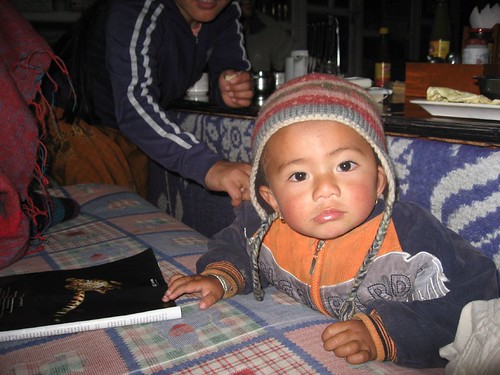
Nepali boy at Himalaya Guest House in Chomrong
Lessons Learned
Western companies and tour groups are not the way to go. Who wants to walk in such majestic places with a giant crowd of people no doubt talking to one and other all the time.
Support Nepali travel agencies, guides, and porters. It's cheaper and gives you a closer cultural connection.
It's as easy to hire a guide and porter for a trek in Nepal as it is to go skydiving in New Zealand. And there's no paperwork to sign!
Be clear about the goals of your trek when hiring a guide. If you want to be able to take your time, then stress that reaching base camp is not critical.
On the popular routes (Sanctuary, Circuit, Everest), guides and porters are not necessary. Take a book or a map; however, the maps and trails are so obvious it'd be hard to get lost.
If traveling during the high seasons, there are plenty of other trekkers to meet in advance or along the way, and guides are always around for you to ask questions (how far is it to X, what do you think the weather will be like today, etc.).
Prepare for all weather conditions. Ask, “what happens if I get caught in the rain my first day?”
At the same time, don't feel the need to bring an entire waterproof outfit, as you can usually do your walking in the mornings before it rains, and dry your wet clothes (or laundry) by the guest house stoves or heaters each night.
Layering is essential. I wore 1-4 layers at any given point in the day/night. It would be blisteringly hot under the sun at times, and cold in the evenings.
Invest in an authentic sleeping bag, and know how it performs in varying degrees of cold. I'd rather be too warm than too cold.
Gela was comfortable in her friend's real North Face -7 degree Celsius sleeping bag the whole time, even above 4,000 meters at ABC.
My fake -5 degree bag sucked balls, and I had to depend on guest house blankets and extra clothes (not a good feeling)
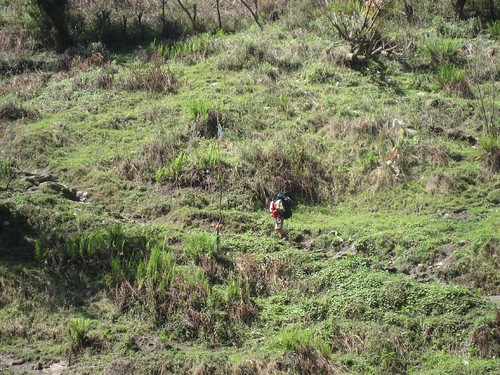
Nima leads the way
- Take your time. Walk slow, watch your steps – up and down. Use a walking stick for added support and balance.
- Greet the locals with “namaste.”
- Drink water and eat snacks (chocolate, granola, etc.) at your rest stops. Drink and eat more than you think you need.
- Drink herbal teas and warm water.
- If you feel worried about the remoteness, the steepness of trails, the weather, the altitude, RELAX and try to stay in the moment, focusing on the scenery and people around you.
- Breathe evenly and deeply.
- Find food you like and eat a lot of it (stay consistent, trekking isn't the time to experiment).
- Establish an eating routine – eat the same meals each day (porridge w/apple for breakfast, pizza/noodles for lunch, dal bhat for dinner).
- Adding sugar to tea, water, and food is an excellent way to consume extra calories and gain quick energy.

Nancy reviews photos with another trekker in Chomrong
Trekker Nationalities (met along the way)
- German
- Austrian
- Dutch
- English
- Swiss
- Estonian
- French
- Italian
- Irish
- Czech
- American
- Polish
- Malaysian
- South Korean
- Israeli
- Canadian
- Thai
- Japanese
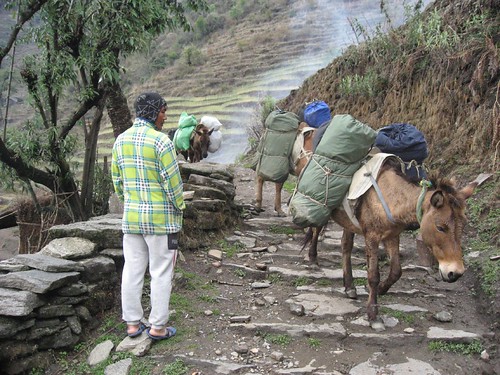
Nima and I watch a donkey train
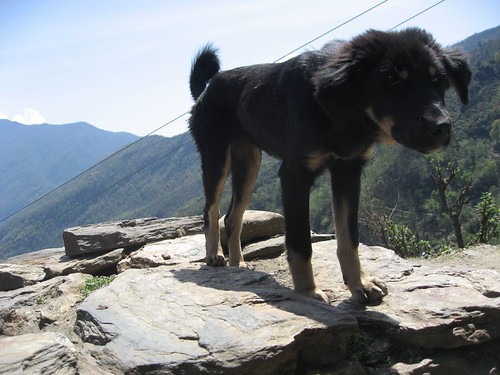
A noble dog of the Himalaya
Truly Final Thoughts
The difficulty of trekking in Nepal will depend on the person, route, time allowed, season, etc.
Having practically no outdoor experience myself, I found the first few days challenging – mentally and physically.
Yes, I tend to worry a bit in life, yet there's no getting around the fact that you quickly realize how much work it takes to travel 1…2…3 days into the mountains, let alone the logistics and effort of trying to get back out if you injure yourself, or mentally lose it.
Despite having hired a guide, I quickly found you need to look out for yourself first and foremost.
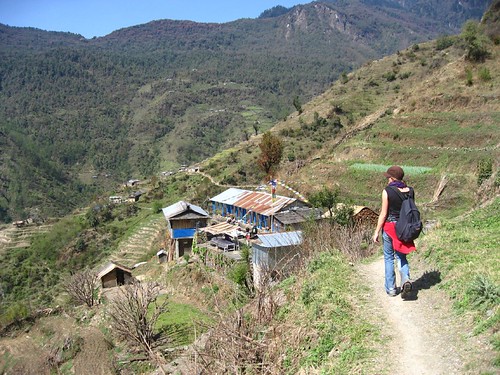
What a view!
Still, on those days when I was waiting for Gela, I started to miss the routine of getting up early and hitting the trails.
We never stretched our legs before setting off – we just started walking. After a few days, your body seems to adapt.
There were as many trekkers in their 40's and 50's as there were in their 20's and 30's.
Despite all my concerns around Altitude Sickness, I never reached the heights where it became a significant concern.
Still, at certain heights, I was acutely aware of the extra effort and breathing it took to do seemingly easy things like going up and down a flight of stairs.
Usually, I was fine after a night's sleep, though. Guess I'll save my Diamox for the next mountain adventure.

Colorful prayer flags
Dave is the Founder and Editor in Chief of Go Backpacking and Feastio. He's been to 66 countries and lived in Colombia and Peru. Read the full story of how he became a travel blogger.
Planning a trip? Go Backpacking recommends:
- G Adventures for small group tours.
- Hostelworld for booking hostels.

Rajendra Pant.
Sunday 15th of September 2013
My name is Yam Bahadur Pant, though I am commonly known as “Rajendra” I born in 1977, then have been working as a Trekking Guide in the Himalaya since 1996, first as a porter and now as a Government licensed guide. As a team leader, myself and my fellow guides and porters work independently taking tourists on treks all throughout the Himalayan region. Having completed my intermediate Arts (Humanities) and currently completing my Bachelors degree, I am able to Fluently speak English, and better learning Spanish. Also as a guide I can provide You with a vast knowledge about the culture, language and local people of Nepal As well as being very hospitable. I am also very passionate about nature, particularly that of the mountains and while trekking I am sensitive and environmentally aware of my surroundings. In my experience I have climbed to heights over 6000 meters. I love my job and being out among the majestic beauty of the mountains and feel that if you choose to do a trek with me you will benefit from my experience, knowledge and passion of the Himalayas!!! There is no question that Nepal offers some of their most spectacular and beautiful scenery in the world. Eight of the world’s ten highest peaks are found here, including the famous Mountain Everest. Hiking through the Himalayas you will be following paths that have been used for centuries and passing through villages with local people from a diverse range of ethical backgrounds. Their warm, outgoing and friendly natures help provide a valuable experience to The trekkers. The lengths of the different treks vary greatly and can be easily adjusted to suite your needs. Some people choose to spend just a few days in the mountains, others stay weeks and even months!! You can string a few popular treks together or just do a part of another trek many treks. Naturally,the best charming people are well-coming you in Nepal for all season.
Stan
Monday 10th of September 2012
I am about to do the Anapurna sanctuary treck. We were going to do it on our own. Is there any need or possibility to make tea house reservations ahead of time?
Dave
Monday 10th of September 2012
No Stan, there's no need to reserve tea houses ahead of time. The only exception might be in the high season (April and October), but even then I think there are enough rooms to go around.
prashant pakhrin
Sunday 13th of February 2011
Hi Dear Trekkers, Namaste!! A warm greeting from Nepal!! This is prashant, I m an experience over the 10 years trekking guide in Nepal!. Hoping to hearing soon from the trekkers.
Dave
Sunday 6th of September 2009
Hi Pot - Thanks for stopping by. I'm sure you'll have a great time! Good luck
Dave
Sunday 6th of September 2009
Hi Pot - Thanks for stopping by. I'm sure you'll have a great time! Good luck